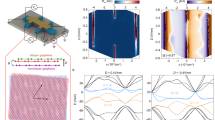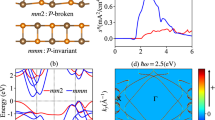Abstract
Crystal symmetry governs the nature of electronic Bloch states. For example, in the presence of time-reversal symmetry, the orbital magnetic moment and Berry curvature of the Bloch states must vanish unless inversion symmetry is broken1. In certain two-dimensional electron systems such as bilayer graphene, the intrinsic inversion symmetry can be broken simply by applying a perpendicular electric field2,3. In principle, this offers the possibility of switching on/off and continuously tuning the magnetic moment and Berry curvature near the Dirac valleys by reversible electrical control4,5. Here we investigate this possibility using polarization-resolved photoluminescence of bilayer MoS2, which has the same symmetry as bilayer graphene but has a bandgap in the visible spectrum6,7 allowing direct optical probing5,8,9,10,11,12. We find that in bilayer MoS2 the circularly polarized photoluminescence can be continuously tuned from −15% to 15% as a function of gate voltage, whereas in structurally non-centrosymmetric monolayer MoS2 the photoluminescence polarization is gate independent. The observations are well explained as resulting from the continuous variation of orbital magnetic moments between positive and negative values through symmetry control.
This is a preview of subscription content, access via your institution
Access options
Subscribe to this journal
Receive 12 print issues and online access
$259.00 per year
only $21.58 per issue
Buy this article
- Purchase on SpringerLink
- Instant access to full article PDF
Prices may be subject to local taxes which are calculated during checkout




Similar content being viewed by others
References
Xiao, D., Chang, M-C. & Niu, Q. Berry phase effects on electronic properties. Rev. Mod. Phys. 82, 1959–2007 (2010).
Mak, K. F., Lui, C. H., Shan, J. & Heinz, T. F. Observation of an electric-field-induced band gap in bilayer graphene by infrared spectroscopy. Phys. Rev. Lett. 102, 256405 (2009).
Zhang, Y. et al. Direct observation of a widely tunable bandgap in bilayer graphene. Nature 459, 820–823 (2009).
Xiao, D., Yao, W. & Niu, Q. Valley-contrasting physics in graphene: Magnetic moment and topological transport. Phys. Rev. Lett. 99, 236809 (2007).
Yao, W., Xiao, D. & Niu, Q. Valley-dependent optoelectronics from inversion symmetry breaking. Phys. Rev. B 77, 235406 (2008).
Mak, K. F., Lee, C., Hone, J., Shan, J. & Heinz, T. F. Atomically thin MoS2: A new direct-gap semiconductor. Phys. Rev. Lett. 105, 136805 (2010).
Splendiani, A. et al. Emerging photoluminescence in monolayer MoS2 . Nano Lett. 10, 1271–1275 (2010).
Souza, I. & Vanderbilt, D. Dichroic f-sum rule and the orbital magnetization of crystals. Phys. Rev. B 77, 054438 (2008).
Xiao, D., Liu, G-B., Feng, W., Xu, X. & Yao, W. Coupled spin and valley physics in monolayers of MoS2 and other group-VI dichalcogenides. Phys. Rev. Lett. 108, 196802 (2012).
Zeng, H., Dai, J., Yao, W., Xiao, D. & Xiaodong, C. Valley polarization in MoS2 monolayers by optical pumping. Nature Nanotech. 7, 490–493 (2012).
Mak, K. F., He, K., Shan, J. & Heinz, T. F. Control of valley polarization in monolayer MoS2 by optical helicity. Nature Nanotech. 7, 494–498 (2012).
Cao, T., Feng, J., Shi, J., Niu, Q. & Wang, E. Valley-selective circular dichroism of monolayer molybdenum disulphide. Nature Commun. 3, 887 (2012).
Akhmerov, A. R. & Beenakker, C. W. J. Detection of valley polarization in graphene by a superconducting contact. Phys. Rev. Lett. 98, 157003 (2007).
Rycerz, A., Tworzydlo, J. & Beenakker, C. W. J. Valley filter and valley valve in graphene. Nature Phys. 3, 172–175 (2007).
Zhu, Z-G. & Berakdar, J. Berry-curvature-mediated valley-Hall and charge-Hall effects in graphene via strain engineering. Phys. Rev. B 84, 195460 (2011).
Korn, T., Heydrich, S., Hirmer, M., Schmutzler, J. & Schuller, C. Low-temperature photocarrier dynamics in monolayer MoS2 . Appl. Phys. Lett. 99, 102109 (2011).
Radisavljevic, B., Radenovic, A., Brivio, J., Giacometti, V. & Kis, A. Single-layer MoS2 transistors. Nature Nanotech. 6, 147–150 (2011).
Novoselov, K. S. et al. Two-dimensional atomic crystals. Proc. Natl Acad. Sci. USA 102, 10451–10453 (2005).
Eda, G. et al. Photoluminescence from chemically exfoliated MoS2 . Nano Lett. 11, 5111–5116 (2011).
Cheiwchanchamnangij, T. & Lambrecht, W. R. L. Quasiparticle band structure calculation of monolayer, bilayer, and bulk MoS2 . Phys. Rev. B 85, 205302 (2012).
Zhu, Z. Y., Cheng, Y. C. & Schwingenschlögl, U. Giant spin-orbit-induced spin splitting in two-dimensional transition-metal dichalcogenide semiconductors. Phys. Rev. B 84, 153402 (2011).
Yoon, Y., Ganapathi, K. & Salahuddin, S. How good can monolayer MoS2 transistors be? Nano Lett. 11, 3768–3773 (2011).
Popov, I., Seifert, G. & Tománek, D. Designing electrical contacts to MoS2 monolayers: A computational study. Phys. Rev. Lett. 108, 156802 (2012).
Radisavljevic, B., Whitwick, M. B. & Kis, A. Integrated circuits and logic operations based on single-layer MoS2 . ACS Nano 5, 9934–9938 (2011).
Lee, C. et al. Anomalous lattice vibrations of single- and few-layer MoS2 . ACS Nano 4, 2695–2700 (2010).
Jiménez Sandoval, S., Yang, D., Frindt, R. F. & Irwin, J. C. Raman study and lattice dynamics of single molecular layers of MoS2 . Phys. Rev. B 44, 3955 (1991).
Chakraborty, B. et al. Symmetry-dependent phonon renormalization in monolayer MoS2 transistor. Phys. Rev. B 85, 161403 (2012).
Balocchi, A. et al. Full electrical control of the electron spin relaxation in GaAs quantum wells. Phys. Rev. Lett. 107, 136604 (2011).
Koralek, J. D. et al. Emergence of the persistent spin helix in semiconductor quantum wells. Nature 458, 610–614 (2009).
Acknowledgements
The authors thank B. Spivak for helpful discussions. This work is mainly supported by the US DoE, BES, Division of Materials Sciences and Engineering (DE-SC0008145), and device fabrication is partially supported by the NSF (DMR-1150719). A.J. was supported by the NSF Graduate Research Fellowship (DGE-0718124). G-B.L. and W.Y. were supported by the Research Grant Council of Hong Kong (HKU 706412P). W.Z. and D.X. were supported by US DoE, BES, Division of Materials Sciences and Engineering. D.C. and Z.F. were supported by the DoE BES (DE-SC0002197). The DFT calculations were performed at the National Energy Research Scientific Computing Center supported by the DoE Office of Science. Device fabrication was performed at the University of Washington Micro Fabrication Facility and NSF-funded Nanotech User Facility.
Author information
Authors and Affiliations
Contributions
All authors discussed the results and made critical contributions to the work.
Corresponding author
Ethics declarations
Competing interests
The authors declare no competing financial interests.
Supplementary information
Supplementary Information
Supplementary Information (PDF 737 kb)
Rights and permissions
About this article
Cite this article
Wu, S., Ross, J., Liu, GB. et al. Electrical tuning of valley magnetic moment through symmetry control in bilayer MoS2. Nature Phys 9, 149–153 (2013). https://doi.org/10.1038/nphys2524
Received:
Accepted:
Published:
Issue date:
DOI: https://doi.org/10.1038/nphys2524
This article is cited by
-
Accurate first-principles simulation for the response of 2D chemiresistive gas sensors
npj Computational Materials (2024)
-
Role of active edge sites of atomically thin CVD-grown MoS2 layers on the enhanced visible-light photocatalytic activity
Journal of Materials Science: Materials in Electronics (2024)
-
Investigating valley-dependent current generation due to asymmetric energy dispersion for charge-transfer from a quantum dot to single-walled carbon nanotube
Scientific Reports (2023)
-
Uncovering spin-orbit coupling-independent hidden spin polarization of energy bands in antiferromagnets
Nature Communications (2023)
-
Energy Levels of Quantum Dots in Monolayer of Molybdenum Disulfide MoS\(_2\)
International Journal of Theoretical Physics (2023)



